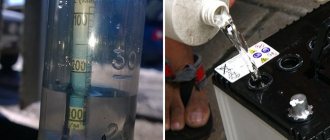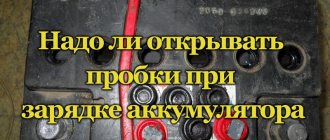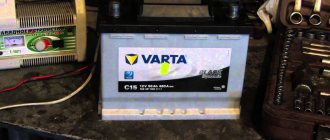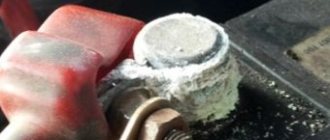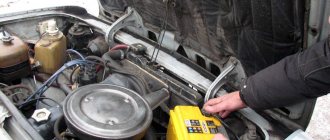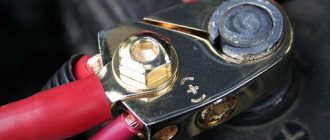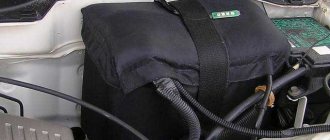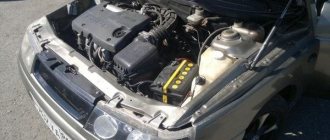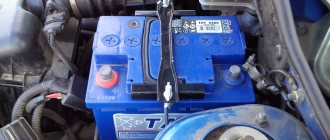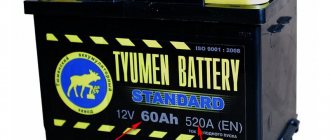During the charging process, one can does not boil. My actions
To begin with, I’ll tell you what “banks” are - these are compartments of the power source that contain a package of lead plates. There are six of them in total, each can or container in a charged state gives approximately 2.1 Volts, if you connect them one by one, then here you have - 12.6 (12.7) Volts.
This effect during the charging process can be seen on the serviced power sources, and it is there that you can easily and simply unscrew the plugs and watch the can boil. However, first I want to tell you why the boiling effect occurs?
FOR WHAT IS THE REASON ARE THE COMPARTMENTS BOILING AND IS THIS NORMAL?
Of course, this is a completely normal phenomenon; it shows us that the battery is charged, and as a result, gas emission occurs. Under the influence of an electric current, water begins to disintegrate into volatile hydrogen and oxygen, they flutter upward in the form of bubbles. It must be said that this gas is extremely explosive - if even one spark hits it or there is an open flame nearby, it can simply lead to an explosion of the power source, and this is not a joke.
If we see bubbles, then this should already tell us something, more precisely, that the time has come to remove the power source from charging, recharging will also not do anything good - the boiling intensity will only increase, the degree of water in the containers will soon fall, since all the water leaves the electrolyte of the power source. As soon as the plates are exposed (which must be completely immersed in the electrolyte), they will begin to heat up and then they will likely be destroyed.
Some car owners intentionally allow the battery to emit gas, all because it is possible to increase the density of the electrolyte and “bring it up” to the required level. Since the water boils away and the acid remains, the density in the battery increases.
As a result, you need to wait for bubbles, but do not overdo it; apply low currents, otherwise it will boil intensely, which can really break your power source.
WHY IS ONE “COMPARTMENT” NOT BOILING?
I repeat, there are not so many reasons as such, sometimes this indicates a breakdown of the power source - it’s simply time to replace it, but sometimes it happens that the power source can be revived, in a little more detail:
- The boiling process does not occur, because a foreign object is closed, or the plates are sprinkled, and as a result the charging process does not occur.
- The battery has simply expired. The last container was completely sprinkled, the electrolyte in it was cloudy.
What to do in such a situation, either throw away the power source or leave it? My advice to you is that there is no need to rush, because half of the time it can be revived.
I will say this, if one way or another you throw away the power source, you can experiment with it - a friend of mine managed to restore the battery, nothing difficult at all, you just need to think about it.
First of all, you need to revive the container - remove the foreign object from it. Sometimes it’s enough to “rinse” it, sometimes radical methods are necessary, as described in this article. If there is a truly small piece that “shorts” the plates, then the performance will be restored by 90 - 95%. Next, you need to charge this one container.
What to do?
I will say this, if you still throw out the battery, you can experiment with it - a friend of mine managed to revive the battery, in principle, nothing complicated, you just need to think about it, so let’s go point by point:
- To restore a jar is to remove a foreign object from it. Sometimes it is enough to “rinse” it, sometimes drastic methods are needed, as described in this article. If there is really a small piece that “shorts” the plates, then performance will be restored by 90 - 95%. Then you can charge this one compartment, or read the second point.
- Charging is also easy . You need to “set” all the banks to “zero” (that is, they are, as it were, “leveled”), usually this is done by a load, for example, you can connect a lamp from a headlight to the terminals. In about a day the battery will be completely discharged. Then we put the battery on charge, now all “compartments” should absorb the energy, that is, six will already be boiling.
- If you dismantled the cloudy compartment , pulled out a package of plates, and they crumbled in your hands, then there is nothing you can do here, this is complete destruction. Most likely, the picture is the same in other banks. So it’s just a matter of buying a “new” battery!
To be honest, it is not always possible to restore it, and washing does not help, only experienced craftsmen can do this for you. The first point is the most difficult, you will have to cut the battery case, but there is acid in there (be sure to protect your hands) - if the restoration was successful, then you need to hermetically seal the case.
I would like to summarize the subnetwork and assign you a brief action plan.
If one jar does not boil, then:
- We look at the electrolyte - in a transparent battery (made of white plastic) it will be visible through the walls, if the battery is dark in color, then you need to “suck it in” with something (ideally a hydrometer) and pour it, say, into a glass.
- If the liquid is clear , then most likely the jar is either shorted or not fully charged. If the liquid is cloudy, there is a high probability that the plates will completely fall off.
- If the liquid is clear, we first try to equalize the charge. We discharge to zero, then recharge. If again everyone is boiling, but one is not. So, we'll take it apart.
- We cut the upper case - take out the plates and look, if there is a short circuit, eliminate it, return the plates back, fill them with electrolyte, and solder the case.
That's all, now let's watch the video version of the article.
This is where I end, I hope the article was useful to you, read our AUTOBLOG
Similar news
- How does a car battery work? Briefly about the device + view...
- Green light on the battery (built-in indicator). What do...
- How to increase the electrolyte density in a battery. Independent…
Add a comment Cancel reply
The battery bank is shorted - what to do?
A car battery is a storehouse of electrical energy, the renewable supply of which occurs due to an electrochemical reaction in several cells. Each bank provides equal amounts of energy. The elements are connected in series, the voltage in the battery is equal to the sum of the resulting potential differences of all banks. If one element fails, the battery becomes unusable. How to find out the cause of the malfunction - is the bank shorted in the battery or is there an open circuit?
Checking the battery with a multimeter
A multimeter is a device that is used to measure voltage. It is better to use a digital device, as it is more convenient to work with. Before checking a car battery with a multimeter, you will need to switch it to constant voltage monitoring mode. Then you need to set the range higher than that declared by the battery manufacturer. Next, connect the black probe to the negative socket, and the red probe to the positive socket. The information is displayed on the device display and recorded.
After all measurements have been completed, the electrical circuit must be disconnected. To obtain the most accurate readings, it is recommended to take measurements after several hours of disconnecting the battery. The temperature indoors or outdoors does not affect the data acquisition in any way.
Battery banks are shorted - symptoms
Here is a classic lead acid battery consisting of 6 cans. Each of them is composed of pairs of oppositely polar plates. Their contacts are collected into a common collector, connected in series and connected to the cover with two terminals. Modern cans have a different design, but the layout of the cans and cells is the same.
With a series connection, the cell voltages are summed up, and the capacity is determined by the most clogged bank. To charge the battery, voltage is applied to the terminals and current flows through the storage areas. Why do banks short circuit in a lead-acid battery? If for some reason the plates in the jar get closer together, the walls swell, a jumper is created, and the cell is closed. It happens that a contact bridge is created by a piece of crumbled putty or scale.
How can you check if the battery is short-circuited? When measuring the voltage at the terminals, a dip will be detected. For example, a 12 V battery consists of 6 cans with a total voltage of 2.1 * 6 = 12.6 V. The voltage drops to 10.5-11.0 V - look for a closed can.
One of the plates inside the jar is lead, and the other has a layer of active substance applied to it. If the electrolyte level is violated or overcharged, the mass may crumble and short-circuit the plates.
Mechanical damage from the outside can lead to deformation. It is possible that the battery case is swollen, and then internal short circuits of the plates in the banks are possible. This can happen when the electrolyte freezes and from overcharging a maintenance-free battery.
Symptoms of a shorted battery bank are loss of voltage, heating of the battery case. The battery does not charge to 12 volts, is unable to crank the starter, and requires replacement. Sometimes when charging you can hear the smell of rotten eggs - hydrogen sulfide gas is released.
Is the boiling process normal or not?
A car battery only looks like a solid device from the outside. It is actually made up of self-contained compartments called cans. Their number is equal to the number of plugs, usually 6 compartments. In fact, they are only partially isolated from each other - they are connected to each other by the electrolyte poured into the battery. Insulating the plates is a necessary measure to reduce the risk of failure of the entire battery due to short-circuiting and other troubles.
In a normal, fully charged state, each bank is capable of producing a voltage of 2.1 V. Since they are connected in series, the potential difference between the extreme terminals of the battery will be the arithmetic sum of the voltages in each of the banks, that is, 12.6 V.
Under normal conditions, the car battery does not need to be recharged, since this function is performed by the generator. The autonomous power supply is used only when the engine is turned off. Usually to start the engine, but many motorists consider it okay to listen to music or use gadgets even when the power unit is idle.
One way or another, there are situations when the battery is so discharged that the driver begins to experience difficulty starting the engine, and to normalize the situation, the battery is charged.
Expensive chargers from well-known manufacturers can do this automatically, turning off charging as soon as the voltage in the banks reaches the nominal values. Cheap chargers will continue to supply voltage to the battery terminals, and when the density of the electrolyte reaches a certain value, under the influence of current, the water that is part of the electrolyte begins to decompose into oxygen and hydrogen. Both gases will tend to the surface of the liquid in the form of bubbles. This process is called boiling of the electrolyte.
When the liquid begins to boil, this is a signal that the battery needs to stop charging. If this is not done, boiling will contribute to an increase in the density of the electrolyte: the proportion of light water will decrease, and the concentration of sulfuric acid will increase. The more water evaporates, the lower the electrolyte level will be. If boiling occurs for a long time, the battery plates may become exposed - they are usually covered with a one and a half centimeter layer of liquid. In contact with air, the heated plates begin to collapse, which leads to a decrease in their original capacity.
So you need to control the charging process, especially when using inexpensive or homemade chargers.
However, some motorists deliberately recharge the battery if its density is below nominal, reducing the proportion of water. This method is applicable, but you need to understand that in this case the electrolyte level decreases, and it will need to be topped up.
So boiling, if short-lived, is unlikely to cause much damage to your battery, and in some cases it will even be beneficial.
Signs of a shorted battery bank
Since charge is being redistributed inside, the battery case heats up, which is one of the signs of an internal short circuit. If the battery is serviceable, you can determine the shorted bank during charging. At the moment the voltage rises, the plugs on the cans are open, hydrogen is released from them, and the cans boil. If one does not show signs of life, it is closed. You can check and find the cause of undercharging of the battery in a ventilated area or outside.
If a voltage drop occurs in a maintenance-free battery, the device does not charge to operating voltage, as you can determine if the bank is shorted, or for another reason. Experts advise closing the contacts for 1-3 seconds. A copious discharge will begin from the non-working jar.
Even a maintenance-free battery allows you to see the electrolyte level in the jars through the translucent walls. Signs of a closed jar will be a reduced level of electrolyte - it boils away, sometimes a noticeable change in color to black.
Methods for determining a boiling battery
If you have a serviceable battery, then this process is easiest to determine visually. For example, as shown in the video below:
If you have the most common maintenance-free battery today, then the boiling process can be determined by indirect signs.
- The first most common sign of boiling is the appearance of a greenish coating and abundant oxides on the battery terminals, such as those shown in the figure below;
- Another sign of boiling is the smell of electrolyte appearing in the engine compartment. It is quite sharp and can be heard even by people without a keen sense of smell;
- Another sign may be the appearance of rust on the hood in the area of the battery and severe corrosion of the battery shelf;
- There are also exotic ways to determine the boiling process. Some drivers, when they suspect a boiling battery, connect a balloon or a condom to its gas outlet tube. If the battery is boiling, it will begin to inflate;
- Another exotic way is to use a medical stethoscope. If you apply it to a boiling jar, you can hear a characteristic gurgling sound;
How to identify a closed cell in a battery
Technically, you can determine a closed bank by measuring the voltage on each bank separately with a voltmeter. To measure the voltage on each bank you need to use a load fork. Under load, the voltage of the can below 1.7 V indicates its defect.
The most reliable testing method is carried out on a completely discharged battery. The battery should produce a voltage of 12 V. The indicator is less by a number that is a multiple of 2 and will determine how many cans have become unusable. In the future, you will need to determine why the bank closed. If the battery is expensive and new, less than 3 years old, it can be revived. But for this you need to have plumbing skills, tools and follow safety precautions.
Reasons for the short circuit of cans in the battery
The main problem is failure to follow the operating instructions for the car battery. Closely spaced plates, active putty on the gratings, are precisely designed to work under the flood, with voltage within the permissible limits. The crumbled mass, sulfation, and a sharp blow to the body are a prerequisite for the contact of the plates with opposite charges. If one bank is overloaded, it will discharge faster, become sulfated, and the first one will fail.
What should I do to prevent the battery from shorting out and to keep it working for a long time? Keep the battery clean, avoiding unnecessary self-discharge currents. Do not leave a discharged battery for a long time without recharging. In the cold, a discharged battery will freeze because it contains a weak electrolyte. Often, just because of 1 cell of battery, you have to recycle the entire battery. There are several reasons why it can close:
- Factory defects are a warranty case.
- Strong blow to the body.
- Chronic undercharging and overdischarging is the most common cause of malfunction.
Recovering a shorted battery bank
Once it has been possible to understand that the car battery banks are shorted, it is necessary to evaluate the work to restore the cell and compare it with the purchase of a new device. If more than one can is shorted, there is no point in wasting time and effort on repairs. How do you know if there are still jumpers in other elements? They can appear if the layout of the case is disturbed or the connections are loosened.
Step-by-step instructions on how to restore a shorted battery bank.
- Identify a non-working jar based on the listed characteristics.
- Extract the electrolyte using special means, working in glasses and rubber gloves.
- Cut the plastic around the top of the cell.
- Disconnect the jumpers with adjacent elements and carefully remove the package of plates, rinse them from acid.
- Determine the location of the short circuit - a piece of metal, a bent plate, remove sediment at the bottom.
- Place the structure in place as it was, fill in the electrolyte, and secure the lid with glue.
- Fully charge the battery.
This is how lead batteries of older models and those produced in Europe are restored. Maintenance-free batteries must be protected from deep discharge. It is difficult to repair them yourself.
Reasons why one of the cans does not boil
Over time, every battery can succumb to the “not boiling” problem. Such breakdowns occur extremely often. You should understand how the cells of car batteries are designed and the reasons why the electrolyte does not boil in all banks.
Battery banks are some kind of batteries consisting of plates made of lead, inside of which there is an electrolyte (a special substance containing sulfuric acid and water). This design is located in a special cylindrical container.
After connecting the device to the charger, chemical reactions begin to occur in the jars. Due to this process, electrical energy is stored in the battery. The most common battery (namely 12 volt) contains six cells.
Attention! It is necessary to charge the car battery until the cans boil. After this, you shouldn’t sit and look at the bubbles for a few more hours. This will get you nowhere.
You can still leave the device to charge for a short time after boiling. This will increase the density of the electrical fluid. This happens, after the water boils away, only sulfuric acid remains. But still, you shouldn’t expect anything good from recharging. This only harms your device.
Should a car battery boil when charging - what to do in this case?
When the electrolyte begins to boil when charging a battery, many car enthusiasts have questions about the possible consequences of this phenomenon. For each battery, such processes have different intensity: from the release of small bubbles to active seething. We'll tell you why this happens and what measures need to be taken in such cases.
Reasons for the boiling process
To understand whether a battery should boil at the end of charging, it is necessary to find out the reasons for the occurrence of this phenomenon, and for this let’s remember school courses in chemistry and physics. Modern cars use lead-acid batteries as a source of electricity. Most batteries have 8 or 6 sections (cans), each of which contains lead grids immersed in an electrolyte - an aqueous solution of sulfuric acid.
When a charger is connected, many chemical reactions occur inside the battery, but we are interested in the reaction that causes “boiling”. When current is applied to the lead grid, a chemical reaction occurs in the solution - electrolysis of water. The release of hydrogen and oxygen begins with a simultaneous increase in the density of the electrolyte. Motorists call this phenomenon boiling, although in our case this is not entirely true. The temperature of the hydrochloric acid solution does not reach the value at which boiling begins, and the observed processes are the release of detonating gas (a mixture of oxygen and hydrogen).
It turns out that a working battery should “boil” during charging. This process indicates the formation of electromotive force, as well as the rapid completion of recharging.
What actions need to be taken?
The answer to this question depends on the intensity of gas emission, as well as on when the seething began. In a working battery, gases are released when the charge reaches 30%. This happens 2-3 hours after connecting the charger (charger). As the density of the electrolyte increases, the amount of gas released will increase. Normally, there should not be a lot of bubbling; a small amount of bubbles is acceptable and you should not be afraid of this. 3 hours after the start of boiling, you can turn off the electric current source.
Prolonged boiling of the electrolyte will damage the battery.
Avoid situations where the battery boils for more than three hours, this may harm its performance. In the best case, the electrolyte will partially boil away; for maintenance-free batteries, such a problem is fatal. In addition, if the electrolysis process is prolonged, the battery will fail. First, lead sediment will appear at the bottom of the cans, which can lead to short-circuiting of the electrodes, and then the lead plates will begin to deteriorate.
It should also be remembered that the oxyhydrogen gas released during electrolysis is dangerous. Follow these guidelines when charging batteries to extend battery life and protect yourself:
- Before starting charging, unscrew all plugs. This rule applies even to devices equipped with safety valves. They cope with their task during operation, but during charging they will become an obstacle to the release of gas;
- do not place the battery near sources of open or closed fire, do not smoke nearby, do not touch the terminals - this will protect against an explosion;
- Charge the battery in a well-ventilated area.
If charging is done outdoors, make sure that no debris gets into the jars. You will not be able to get it out, and the slightest particle may get stuck between the lead plates, which will lead to a short circuit.
Troubleshooting Possible Problems
Motorists may experience a situation where boiling occurs, but the battery does not charge. This usually happens when the electrolyte level in the banks decreases. If the battery is maintenance-free, you will have to throw it away. In other cases, you can try to revive the battery using our instructions:
- unscrew one plug;
- carefully pour the electrolyte into a glass jar;
- pay attention to its color (normally transparent, when the plates fall off - dark);
- if the color has not changed, fill the electrolyte to the required level and tighten the cap;
- repeat the previous operations with each jar, then connect the charger.
This way you can determine what caused the problem. If the electrolyte is transparent in all banks, then the reason is a decrease in its level. This happens when the battery is stored for a long time, the seal of the case or plugs are broken. If the electrolyte is cloudy, this means that the lead plates have crumbled and a short circuit has occurred. If the damage is minor, you can try to repair the battery yourself.
Moderate boiling of the battery is normal.
While charging the battery, one can does not boil - searching for reasons
During the charging process, a situation may arise when one or two cans do not boil. This indicates a malfunction of the compartment - complete destruction of the lead plates or a short circuit between them. In the first case, the battery cannot be restored. Even if you manage to change the lead plates, after a while the next can will fail. The process will continue to increase, and the battery will still have to be thrown away.
By following the instructions above, you can determine the cause of the breakdown. When shorted between the plates, the electrolyte will not change its color. If this is exactly the case for you, then you can try to revive the battery:
- drain the electrolyte from the idle can;
- try shaking the battery, if the problem is caused by debris stuck between the plates, then when shaking it will fall to the bottom of the jar;
- rinse the compartment 2-3 times with boiled water;
- fill the washed jar with electrolyte of the required density;
- connect the charger and check if the battery is charging.
In some cases, such primitive measures help, and the battery comes back to life. If the jar still does not boil, you will have to do an “opening”:
- drain the electrolyte;
- cut off the top of the compartment;
- the gratings of each compartment are connected to each other by a lead plate, so cut it;
- remove the package of lead plates;
- examine it.
There are plastic insulators between the plates; sometimes their integrity is broken and the plates touch each other. This shouldn't happen. Align them carefully and check for other irregularities in the block. If everything is in order, collect the battery.
There are times when a small section is separated from the grate (masters call it a “short section”). The distance between the plates is insignificant, the “short one” stands across, and the electrodes short-circuit. Using a knitting needle or tweezers, carefully remove it. Once you have fixed the problem, proceed to reassemble in reverse order:
- carefully place the lead block back into the jar;
- solder the lead strip;
- place the cut top plastic part on the glue (it is better not to glue, but to solder);
- fill in the electrolyte of the required density;
- connect the charger.
Often, having completed all the steps to restore the battery and connected it to the charger, a person notices with disappointment that the can does not boil again - this is understandable. You have already tried to charge the battery, so the working banks have gained the required charge and are boiling, but the compartment that you repaired is not yet charged - the result is uneven charging. To solve the problem, you need to equalize the charge level in each bank. To do this, connect wires to the battery terminals, and a car light bulb to them. The load should not be large, so a car light bulb is the best option. Such a simple device will discharge all compartments to zero in a few days.
What actions need to be taken?
Next, we will present an algorithm for repairing the device when the cause has already been established.
Restore the energy storage cell.
First you need to open the cell and remove from the jar the object that is interfering with the boiling. You can simply clean the compartment, but often you need to resort to special methods. If the device does not work due to a small piece of object, you can significantly increase its level of functionality. After the above steps, you only need to infect one jar. When carrying out this procedure, you should protect your hands with gloves; you will have to work with sulfuric acid.
Compare cells
The next step is to equalize all the jars. They need to be completely discharged. This can be done using any load. It will take about a day for the battery to completely discharge. Then we set the device to become infected. After carrying out this procedure, all six cells should begin to boil.
Analysis of the cloudy compartment
Nothing can be done if, when removing the plates, they crumble right in your hands. All that remains is to throw away the old battery and buy a new one.
Bringing your device back to life is quite a difficult task. If you are not confident in your capabilities, it is better to seek the help of a qualified specialist.
When working with hazardous substances, you need to protect yourself with protective clothing. It is necessary to protect the skin, eyes and mucous membranes. When dealing with such a device, you should not be near fire or places that produce sparks. Be sure to seal the case well to prevent an explosion or fire.
How to identify the cause of the breakdown
If one of the compartments is not seething, you should first identify the cause of this problem, and then take some measures to eliminate it. The cause of the breakdown can be determined using the following criteria:
Appearance of electrical fluid.
By the way the electrolyte looks, you can find out what contributed to this problem. This will be visible through the walls of the transparent battery. When it is dark, a hydrometer will come to the rescue. By sucking in the substance with this device, you can examine the liquid and understand why the jar is not bubbling.
The substance is transparent in color.
If the mixture has no color, the compartment is simply closed. The cause must be sought in a foreign object. It is possible that the battery is not charged enough. In this case, you should level the battery charge.
The electrolyte has a cloudy tint.
A cloudy hue of the electrical fluid means the plate is destroyed. It is worth removing the plates from the device, checking for short circuits, and inserting them back. Next you need to add liquid and solder the structure. Remember - the work must be carried out carefully and competently.
Why do they boil and is this normal?
The first thing to note is that banks are called compartments in batteries. There are lead plates inside them. In total, car batteries use 6 compartments, that is, cans. Each of them, when fully charged, produces 2.1 Volts. When connected in series, we get the same 12.6 or 12.7 Volt battery.
Boiling car battery
The boiling effect is not difficult to see with your own eyes if you have a serviced battery in front of you. To look at the seething, just unscrew the special plugs. However, not everyone understands why the compartments boil, and whether such behavior is the norm for batteries.
Yes, boiling is considered a completely normal process, which often only indicates that the battery is already fully charged. This causes gas to be released. When exposed to electric current, the water inside the battery gradually breaks down into oxygen and hydrogen. Because gases are lighter than water, they tend to rise and come out as bubbles.
The gas released in this process is highly explosive. Under no circumstances should sparks or contact with open flame sources be allowed. Otherwise, you risk exploding the battery and damaging everything around the battery. That is, trying to look at the bubbling liquid in the battery by illuminating it with a lighter or matches is a very bad idea.
When bubbles begin to appear, this clearly informs the car owner that the device is charged, and you can disconnect it from the charger. You should not leave the battery connected to the charger for a long time, since then the overcharging effect will begin. There is nothing good about it. The boiling activity will increase, the liquid level will gradually begin to fall as water leaves the electrolyte.
In the normal state, lead plates are deliberately completely immersed in the electrolyte. This is by design to avoid overheating and ensure efficient operation. If the electrolyte level drops, then the plates will be exposed. In the future, you will experience overheating and destruction of the battery with all the ensuing consequences.
There is a category of car owners who are trying to specifically provoke the release of bubbles. Thus, they strive to increase the density of the electrolyte used in batteries. The calculation is that the excess water will supposedly boil away and evaporate, but the acid will remain in its place. Due to this, the density will increase.
Restoring a car battery bank
There is nothing terrible in waiting for the bubble to bubble while charging the battery on a special device, and then immediately turn off the power to the charger. Just don’t overexpose and let the battery boil for too long. At the same time, it is better to maintain a short boil at low currents, so as not to provoke excessively intense boiling and gas evolution. If you apply a high current, the bubbling will be too active, thereby rendering the battery completely unusable for further use.
Why one compartment may not boil
But sometimes it happens that when charging a car battery, one of the cans does not boil. Some car owners immediately begin to worry, panic and send the battery to a well-deserved rest.
Car battery boiling process
There are not many reasons for this phenomenon. Sometimes this is really a signal that the battery life is coming to an end, it is no longer capable of working fully and needs to be replaced. But it also happens differently. The absence of signs of seething in one of the compartments does not put an end to the battery, and there is a possibility of its restoration.
It is necessary to clarify in more detail why, when charging your battery, not all available banks boil, that is, not all 6 compartments.
- There is no boiling process, because a short circuit has occurred, there are some foreign objects inside the battery or the plates have begun to crumble. Due to such phenomena, the bank may not receive a full charge. Hence the lack of seething in the compartment.
- An imbalance has occurred. The situation occurs, but is extremely rare. Sometimes it happens that 5 out of 6 cans have already been charged and are starting to boil, but the last one has not yet received the required charge. With such a malfunction, the last compartment boils, but with a slight delay, when the rest are already boiling.
- The battery has exhausted its resource. Rechargeable car batteries should be treated as consumables. They have their own limited lifespan. If the battery is not the most expensive, or purchased on the secondary market, do not be surprised that after 1-3 years of service it will stop functioning normally. The jars may crumble, and the electrolyte inside may become cloudy. There is no point in restoring the battery. You need to buy a new one.
But you shouldn’t rush to send the battery to a landfill when one of the cans for some reason stopped boiling during charging. Yes, if boiling occurs while the engine is running, when the charge is coming from the battery, you need to figure out the reasons and definitely get rid of the battery.
If we are talking about the charging process through a special device, then in approximately half of the cases when there is no seething in one of the compartments, the battery is still recoverable.
